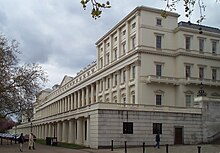Wikipedia:WikiProject Royal Society/Neuroscience Wikipedia Edit-a-thon at the Royal Society, June 2014
| This page is an archive. Do not edit the contents of this page. Please direct any additional comments to the current main page. |


An edit-a-thon on Neuroscience will take place on Saturday, 7 June 2014 from 10:30 to 13:30 (BST): Eventbrite booking page. The form of the event will different from our previous events aimed at scientists, and those with an interest in science, who wanted to learn about editing Wikipedia. This time there will be smaller groups of scientists and experienced Wikipedians who will work together to improve articles. So there will not be the usual workshop-style training, though the scientists attending will certainly come to understand Wikipedia editing processes.
Online participants from both groups will be very welcome. Please bring a laptop if possible; we will have a few spare, but not enough for most people.
This will be the last public event held during John's period as Wikimedian-in-residence, but we hope to continue with other public events in the future.
Participants
- Hugopspiers (talk) 12:33, 7 June 2014 (UTC)
Online participants
If you are interested in participating remotely please sign up below. Edits of those who do will be looked over and any necessary tidying done after the event (we realize the time of the event is not ideal for North America - apologies!). Please also link to any articles you work on, and use the event talk page to raise any queries or issues. I'll do reminders, 2-3 days before, & on the day.
- Anthonyhcole (talk · contribs · email) 13:00, 16 May 2014 (UTC) (I'd appreciate a reminder too.) 05:41, 17 May 2014 (UTC)
- I would appreciate a userpage reminder for me to participate during this event. Blue Rasberry (talk) 14:23, 16 May 2014 (UTC)
- Will be participating from afar. Would also appreciate a reminder. --LT910001 (talk) 05:20, 17 May 2014 (UTC)
- Gordo (talk) 07:58, 29 May 2014 (UTC)
- sign here
Suggested topics
- The cranial nerves (including: Vagus nerve and Facial nerve), and peripheral nerves (Sciatic nerve, Ulnar nerve). These topics all receive more than 25,000 views a month. * Excluding the page "cranial nerves" which is about to undergo GA
- Tracts (Pyramidal tract, Spinothalamic tract) which receive more than 18,000 and in fact anything here: Template:Neural tracts
- Motor neuron
- Pons, Occipital lobe, Frontal lobe
- Receptive field. I've got concerns about the amount of weight devoted to "receptive field" in auditory and other "spaces". The eyes of an expert would be appreciated. Anthonyhcole (talk · contribs · email) 05:55, 17 May 2014 (UTC)
- I'm commissioning a copyright-free 3-D illustration of a nerve (see pencil sketch at right), and would appreciate advice and criticism from experts before submitting to the professional medical illustrators. The level of detail goes from microfibril to epineurium. Once the illustration is complete, it will be reviewed for accuracy by three named independent experts. I want the finished illustration to be definitive — as reliable as the very best sources recommended in our medical reliable sources guideline. Anthonyhcole (talk · contribs · email) 05:41, 18 May 2014 (UTC)
- Create Primary motor neurons perhaps? Gordo (talk) 07:36, 5 June 2014 (UTC)
- See Wikipedia_talk:WikiProject_Neuroscience#Cerebral_cortexes for links to ongoing merger discussions. Wiki at Royal Society John (talk) 00:22, 5 June 2014 (UTC)
Most popular pages
Royal Society journals articles released for 6-8 June
The following journal articles, for which a subscription is normally required, will be freely available online from 6-8 June: these issues have been made free from 6-8th June but just let me know if you would like this changed/extended:
- Synaptic plasticity in health and disease - edited by Tim Bliss, Graham Collingridge and Richard Morris
- Mirror neurons: fundamental discoveries, theoretical perspectives and clinical implications - edited by Pier Francesco Ferrari and Giacomo Rizzolatti
- Understanding perceptual awareness and its neural basis - edited by Antonino Raffone, Narayanan Srinivasan and Cees van Leeuwen
- Timing in neurobiological processes: from genes to behaviour - edited by Valter Tucci, Catalin V. Buhusi, Randy Gallistel and Warren H. Meck
- Seeing and doing: how vision shapes animal behaviour - edited by Ronald H. Douglas and Thomas W. Cronin
- Language in developmental and acquired disorders: converging evidence for models of language representation in the brain - edited by Dorothy V. M. Bishop, Kate Nation and Karalyn Patterson
- Space in the brain: cells, circuits, codes and cognition - edited by Tom Hartley, Colin Lever, Neil Burgess and John O’Keefe
- Female competition and aggression - edited by Anne Campbell and Paula Stockley
- Tool use as adaptation - edited by Dora Biro, Michael Haslam and Christian Rutz
- Attentional selection in visual perception, memory and action - edited by Werner X. Schneider, Wolfgang Einhäuser and Gernot Horstmann
These further items are always free to access: (list to follow)
Articles worked on
- Keith Martin (ophthalmologist) — "the man who prints eyeballs" - started and brought up to DYK level. Andrew (talk) 12:31, 7 June 2014 (UTC)
- Pyramidal tracts (start [1] end [2]) --LT910001 (talk) 12:50, 7 June 2014 (UTC)
- Limbic system